The bulk of our heirloom tomato harvest is now in, albeit somewhat later than years past due in part to our own late planting, and cool summer temperatures. Despite the loss of ‘Big Orange’ this year to blossom end rot, and the mysterious disappearances of a number of our ‘Marvel Stripe’ and ‘Black Pear’ tomatoes, we’ve still had a bounty of sweet flavorful fruits this season.
The Cherry Tomatoes
Each year we plant this trio of cherry tomatoes, Super Sweet 100, Yellow Pear, and Sungold. Some gardeners overlook the value of cherry tomatoes, and others seem to downright dislike them. However, we’ve always found them to be an important part of our tomato gardens. These small, perfectly sweet fruits, help to fill the gap in mid-summer before the larger heirlooms are ripe, and they produce abundantly all season long. They are also fantastic for growing in pots, and most forgiving, even if you don’t have the greenest of thumbs. Many of our cherry tomatoes this year were either consumed straight from the vine, halved and tossed in leafy green or pasta salads, or destined for one of a number of grilled pizzas this season.
The Larger Heirlooms
Black Pear:
This variety was our star performer this season. Black Pear is a Russian tomato, Siberian in origin, and similar in shape to a Roma tomato. It loves our cooler coastal climate, and produced an abundant crop of beautiful dark mahogany-brown fruits throughout the season. This variety was very sweet, but complex, with a slightly smoky tomato flavor. It was sultry in salads, and paired beautifully with fish, especially with our wild Alaskan salmon this summer. Definitely one for next year’s garden!
Big Orange:
Our Big Orange tomatoes succumbed to Blossom End Rot in early September after some extremely hot weather stressed the plant beyond its ability to sustain the fruit. Although the plant is producing a second flush of fruit, it is unlikely that the tomatoes will have a chance to ripen this year before the season ends. Perhaps next year we’ll try revisiting this promising low-acid variety again.
Marvel Stripe:
Clearly a hit with the wildlife here, we haven’t sampled many of these tomatoes ourselves this year. However, the few fruits we have enjoyed were stunning in color, and sweet but mild in flavor. The plants suffered numerous snapped stems when temperatures here soared over 110 degrees one weekend. This variety is not one that we would plant in a container again, but do hope to plant next year in our FULLY FENCED vegetable garden.
Radiator Charlie’s Mortgage Lifter:
Well, we’re not lifting our mortgage with this variety this year. Although the fruits were flavorful, the plant was a poor performer, and didn’t do nearly as well as we hoped. The fruits were significantly smaller than we expected, and few and far between. Again, an interesting experiment growing this in a pot, but clearly a variety that may improve significantly once planted out in the gardens.
Persimmon:
Our other top favorite this year was Persimmon, a yellow-orange colored tomato, producing lots of large fruit. It has a very sweet flavor, and a meaty flesh with few seeds, making it a perfect choice for use on pizza, because it won’t make your crust soggy. It also makes a stunning addition to salads, contrasting beautifully with leafy greens, and the other classically red tomatoes from the garden.
Cherokee Purple:
We once tried growing this variety in the Central Valley, but the extreme heat during the summer months seemed to stifle production. We were curious to see if Cherokee Purple would perform better now that we’re closer to the coast, and we were very pleasantly surprised. The plant was a modest producer this season, but the fruits were quite stunning in size, flavor, and color. Although we’ve avoided growing this variety in recent years, we will be planting this again.
Brandywine:
The plant wasn’t a heavy producer this year, but again, the constraint of the pot no doubt influenced its performance. This tomato has more of a pink colored flesh than true red, and the flavor is rich and sweet. The fruits ripened somewhat later than some of our other varieties, but the taste was worth the wait. We’ll certainly try this variety again.
So despite ravenous rampaging rabbits, snapped stems, and the demise of ‘Big Orange’, we had a very successful tomato harvest this year. Next year we would consider planting any of these varieties again, even the poorer performers, as we recognize that growing conditions this season were less than ideal.
We can’t wait to start planning next year’s garden, however, with literally hundreds of tomato varieties to choose from, the most difficult part of planning any tomato garden is deciding which variety to try next! If you’re looking for tomato varieties to plant in your own garden, we’ve found that the TomatoFest catalog, although somewhat overwhelming in the number of varieties offered, is a very useful online resource, both for learning about the different varieties of tomatoes, and as a source for hard-to-find seed.
If you can’t grow your own tomatoes, or aren’t sure which varieties to grow, an often overlooked resource is your local farmer’s market. They may not have some of the more rare or unique varieties, but they can help you figure out which tomatoes would likely grow best in your area. Experiment, have fun! With all the different tomatoes we’ve grown over the years, we’ve never met a tomato we didn’t like!


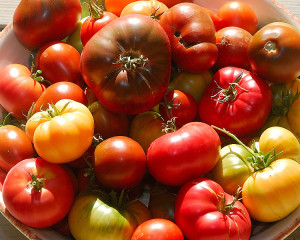
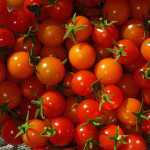
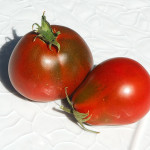


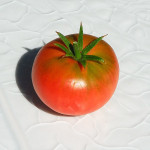
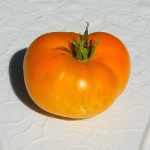
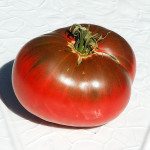
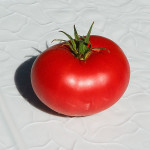







Have you tried adding pelletized lime. Blossom end rot is usually caused by lack of calcium. I used to throw a handful in the container and mix it in with the soil.
You probably know this already, but just in case it helps.
Tomatoes look scrumptious!!!!!
Your harvest beats mine, ours seem to have stalled…it got real cool real fast here in PA…too bad alot left on the vine still green and small
Looks great though, enjoy…..
Tom
You’re right, pelletized lime can help, but B.E.R. isn’t always a sign that there is a lack of calcium. For us this season, calcium was likely sufficient in the soil (using a growing mix in containers, not native soil). Unfortunately, during the extreme heat, it was difficult to stop the pots from drying out, and that probably affected calcium transport to the plant.
Tom, I have a couple of tips for you for next year. Try using the Red Tomato Teepees from gardeners.com We’ve used these for years (also known as ‘Wall-o-Water’):
http://www.gardeners.com/Red-Tomato-Teepees/VegetableGardening_TerrificTomatoes,34-952,default,cp.html
They protect young plants from frost in the early season, enabling you to plant out tomatoes earlier than you could without them, getting a jump on the season. They work like miniature greenhouses for your plants. I used them every year in Felton because we’d lose our sun so early in the season behind the ridge. Also, you might try planting some of the cooler season varieties next year, that mature earlier in the year. I highly recommend the ‘Black Pear’ variety we grew this year. It was an early and consistent producer here. A similar variety is the Japanese Black Trifele. There are lots of other cool climate varieties available too:
http://store.tomatofest.com/Cooler_Climate_Tomato_Varieties_s/47.htm
As for your extra green tomatoes this year…how about a green tomato soup?
http://www.foodnetwork.com/food/cda/recipe_print/0,1946,FOOD_9936_31891_PRINT-RECIPE-4X6-CARD,00.html